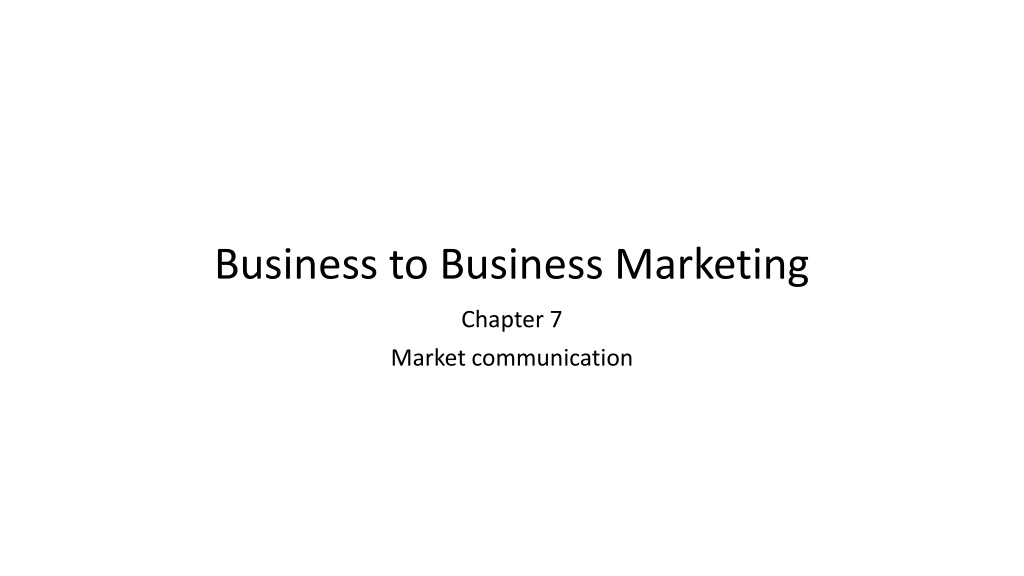Business-to-Business Marketing Communication Insights
Explore the significance of brands in B2B markets, the role of communication strategies, and the impact on business success. Delve into integrated marketing communications, budgeting methods, and the mix of marketing elements essential for effective business communication. Gain insights into strategic decision-making in advertising, trade shows, and more to enhance business brand presence and engagement.
Download Presentation

Please find below an Image/Link to download the presentation.
The content on the website is provided AS IS for your information and personal use only. It may not be sold, licensed, or shared on other websites without obtaining consent from the author. Download presentation by click this link. If you encounter any issues during the download, it is possible that the publisher has removed the file from their server.
E N D
Presentation Transcript
Business to Business Marketing Chapter 7 Market communication
Learning outcomes understand nature and role of brands in business markets and impact of communication on business brands be able to explain meaning and importance of integrated marketing communications understand factors affecting composition of the communications mix in business markets;
Learning outcomes be able to explain budgeting methods used for communications programmes be able to explain role of company websites, content and search marketing, advertising, public relations, sales promotion in business communications mix be able to explain strategic and tactical decisions made by managers in relation to advertising and trade shows
Business brands Meaning and relevance in business markets brands in business-to-business markets are normally at the corporate level so we can explain a brand as comprising the expression and stakeholder images of an organization s identity (Abratt and Kleyn 2012) powerful brand can be critical success factor in increasingly competitive markets (Kotler and Pfoertsch 2007) companies such as Cisco, GE (General Electric) and IBM consistently feature in InterBrands top twenty global brands.
Figure 7.1 Corporate brand Corporate Identity Corporate Reputation strategic choices mission vision strategic intent values culture strategy: formulation & implementation reputation dimensions performance products innovation service citizenship workplace governance corporate expression visual identity brand : promise personality communication brand image experience relationships communities Corporate Brand adapted from Abratt and Kleyn 2012
Figure 7.2. Communication mix and customer acquisition process Communication objectives Potential customers target segments leads Communication Tools awareness advertising PR content and search marketing interest website enquiries content marketing webinars tradeshows prospects online screening telemarketing field sales visits evaluation new customers trial telemarketing field sales visits email and mobile marketing social media marketing established customers purchase transactional and relationship sales teams social media marketing Adapted from Anderson & Narus 2004; Chaffey 2014; J rvinen & Taiminen, 2015)
Figure 7.3: Communicati on automation for customer acquisition campaign objectives and target audiences agreed marketing and sales performance analysed creative content and campaign tools decided target list built using database: contact information, login, cookies or IP addresses warm leads nurtured crm software marketing automation software qualified leads routed to sales/crm campaign executed target response monitored: campaign platform, website, email behaviour and activity prospects segmented according to activity and scoring criteria Source: Adapted from Chaffey (2014); Jarvinen and Taiminen (2016)
Figure 7.4 Influence of information from different sources 9 8 7 6 5 4 3 2 1 0 colleague/friend recommendation sector specific intermediaries supplier website social media platforms via search engines via online display ads via sector specific online communities access to information influence of information source Figure 7.4 Influence of information from different sources Source: Adapted from Buyersphere (2015)
Creating a good first (web) impression present website information that is easily verifiable clearly express the identity of the organization that lies behind the website highlight expert content and services relevant to customer needs signal honesty and integrity via tone of voice and about us, our philosophy and FAQs pages make it easy for site visitors to contact the organization on every page ensure that the site reflects the way that the company does business to ensure consistent online and offline experience make access and navigation easy use frequently updated, relevant and useful content to secure customer data avoid errors! (Power & Chaffey 2012)
Content marketing PR and information-based material used to signal company expertise to stakeholders Digital formats include: company blogs webcasts podcasts whitepapers Accessed via: company, industry, social media sites Relies on: key words for search visibility
Advertising Creative plan Effective b2b print ads rational approach should be used in creative strategy information on performance & product quality should be included and presented in logical manner symbolism and metaphors can be used for selling proposition Lohtia et al 1995
Trade shows/exhibitions Selling tasks: identification of prospects gaining access to key decision makers disseminating facts winning orders account handling Non-selling tasks: building/maintaining company image gathering competitor intelligence product testing/evaluation maintaining company morale Bonoma 1983
Table 7.2 Exhibition centres worldwide by size Insert table 7.2 from typeset manuscript here Source: AUMA, 2018
Visitor reasons for trade show attendance Sales & Marketing General administration Design Engineering R&D Reasons 19.1 16.6 6.66 7.5 4.16 see new products/ developments obtain product/ technical info. try new products/ demos see new companies 0.83 4.16 3.33 7.5 5.0 2.5 4.16 3.33 7.5 5.0 2.5 4.16 1.66 0.83 1.66 3.33 0.83 0.0 0.0 0.83 see specific company/ product discuss specific problems compare products 0.0 0.83 1.66 4.16 1.66 0.83 1.66 0.83 0.0 3.33 Blythe 2002
Figure 7.5 Relative effectiveness of business communication tools Key seller communications objective and tasks New customer/prospect Buying phase Relative communication effectiveness Communications objectives Low High Task need recognition generate awareness prospecting developing product specifications feature comprehension opening relationship qualifying prospect search and qualification of suppliers lead generation qualifying prospect evaluation performance comprehension presenting sales message supplier selection negotiation of terms/ offer customisation closing sale purchase feedback reassurance account service Advertising Trade Personal Shows Selling (Gopalakrishna and Lilien 1995)
























